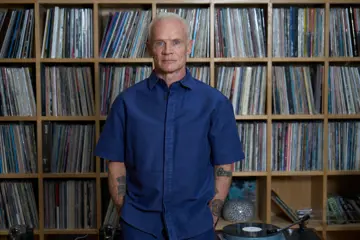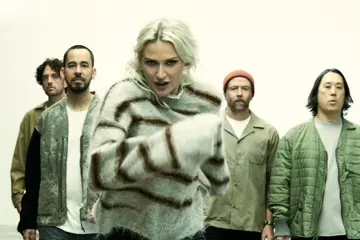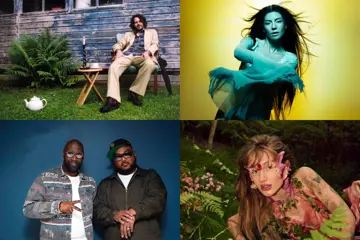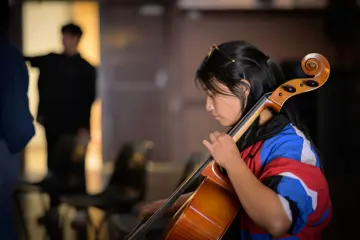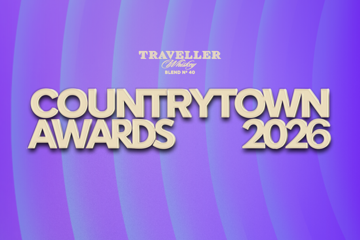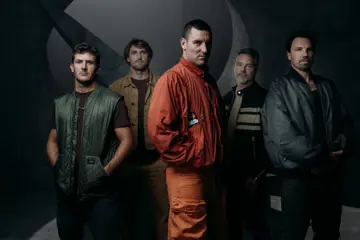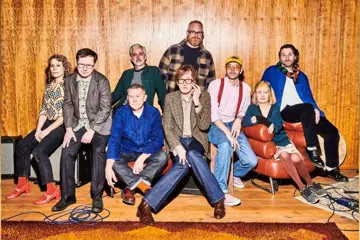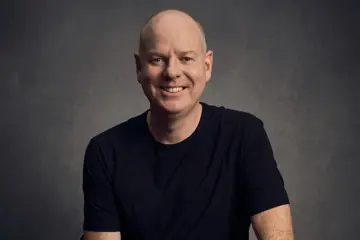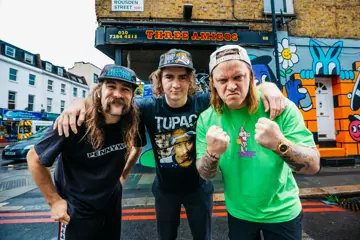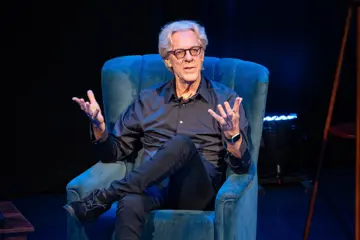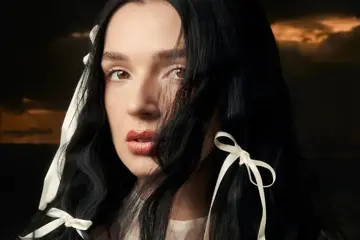For over 20 years respected Australian songwriter, composer and multi-instrumentalist Amanda Brown was assembling the body of work which would come to comprise her beautifully-assured debut solo album Eight Guitars, but it still took a strange convergence of events to make the record a reality.
Coming to national fame in the ‘80s as a member of beloved Brisbane outfit The Go-Betweens, after that band split her vast range of musical talents found her in demand and she spent years recording and performing with artists the calibre of R.E.M., Silverchair, The Church and David Bridie.
Then in 2000 Brown pivoted away from the commercial music realms and began her now flourishing career as a screen composer, one which - despite its share of challenges - has found her working on an impressive array of movies and TV shows, winning multiple AACTA Awards and receiving international recognition for her evocative original scores.
The idea of releasing a solo album had been bubbling away in the background the whole time, but sadly it took the COVID pandemic and lockdowns essentially closing the film and TV industries for the concept to come to real-life fruition.
Don't miss a beat with our FREE daily newsletter
“It had been an idea that had sat on the backburner literally for years,” Brown explains of her solo debut. “I was accumulating these songs from various projects and films and also just writing in my spare time between commissions, so then when COVID happened I thought, 'Well I’m going to be unemployed for the foreseeable future now, so I may as well keep productive and finally get around to doing that record.'
“And one of the great things about doing film music for the last 20 years is that I’ve had to learn technical skills for musical production and recording, and while I wouldn’t say that I’m up there with the best producers by any means I’ve got enough of a skill to nail the home recording.
“So I was able to record all of the overdubs myself and all of the basic tracks, and then when things freed up a little but I was able to go into a studio in Marrickville in Sydney and record all of the rhythm tracks and start sending things through to Tony Buchen in the States who produced the album. So while it all came together pretty organically - and very slowly - over a long period of time, the actual making of the album took probably about two years.
“I’m really quite scared about how it will be received, because I’m not known really as a singer-songwriter and it’s quite foolhardy to be releasing a solo album at my age. But it was really a labour of love and a showcase for some great musicians, and it was an absolute pleasure to make it.”
Eight Guitars is a quietly haunting and sophisticated collection, unveiling at a sedate pace and embracing the use of space throughout, a vibe Brown puts down to the songs themselves rather than any overarching sonic ambitions.
“I think the songs tell you what they want, in a way, although as anybody will tell you there’s different ways you can arrange a song,” she reflects. “But I’m not a great singer - I’m not a diva - although I do have my own voice, but I don’t have a huge range. I’m just not a diva or a belter, and that necessitates quite a soft, acoustic, sparse arrangement.
“The producer Tony has described it stylistically as 'cosmic Americana', and I’m really happy with that description because it marries up to really big musical loves of mine which are that Americana/acoustic/folk tradition and country music, but also I love electronic music and I’m a daughter of the ‘80s so I do love synthesisers and krautrock and a lot of that stuff as well, so I think genre-wise maybe that is what it is.”
The title of the album refers to the disparate array of guest guitarists who feature on each song, giving each track a unique feel without upsetting the album’s overall cohesion.
“The idea of the guitars and getting a different guitarist to feature on each song was really born from the idea that I’m making this album completely of my own volition,” Brown continues. “I have no label but I have creative free rein so why not work with all of my tried and trusted and favourite players, and that was a big part of what made the album such a pleasure to make.
“Also I think with the guitar as an instrument a lot of people play it - and a lot of people love it - but to me I have very particular taste when it comes to guitar, so you won’t hear shredding on this album but you will hear guitarists who have their own unique style and in some instances don’t even really sound like a guitar. I think some of the beauty of it lies in finding the sounds and the aesthetics within the instrument which are perhaps not such a widely-trodden road.
"I think something that also ties the songs all together a bit subconsciously is the fact that I’ve been working so much in screen music for all these years that it can’t help but seep into the songs. They all have lengthy instrumental sections, and that’s quite intentional to feature the various guitarists but it also comes from being a screen composer and loving those moments when your eye lovingly rests for a moment on an image or a wonderful synergy of the moving image and music, and those two things coming together can be quite magic.
“So I think that underneath it all there’s kind of a striving for that synergy or aesthetic, so maybe there’s a ‘film-ic’ quality to the album.”
From a lyrical perspective, Brown admits being influenced not only by those writers from her own orbit but also many of those who’d come before her.
“I came from a band The Go-Betweens with two great lyricists in Grant [McLennan] and Robert [Forster] - who were known for their lyrics and were both proudly literate - so for a long while that was quite intimidating because I felt that I couldn’t write a song unless it was at least that good, which is a really high bar,“ she smiles.
“But another big inspiration for me in the first place were the women of country music, people like Loretta Lynn and Dolly Parton who wrote their own songs from the word go and paved the way for the ones who came after them like Joni Mitchell and Carole King. They were writing about concerns that were particular to women, songs like The Pill and One’s On The Way were very domestic, feminine songs and that was the first time I’d heard that in songwriting.
“I heard that and went, ‘Wow, not only can women write songs but they can write great songs,’ and it was inspiring to hear women writing in their own voices.”
Eight Guitars isn’t the first time that Brown has released songs into the public domain, having teamed up with The Go-Betweens’ longstanding drummer Lindy Morrison after that band’s demise from the project Cleopatra Wong, who released two EPs in the early-‘90s with Brown both singing and providing much of the lyrical content.
“I was still finding my feet really, and it was a bit of an ‘out of the frying pan into the fire’ situation. The band had broken up and we were, like, ‘What are we going to do now? We have to start writing songs!’ because let’s be honest I was completely unqualified to do any other job!” she laughs. “But when I listen back to those songs it’s so cringe-y because to me my singing sounds terrible.
“But there were so many great things about that project. It was really fun Lindy and I working together, we made some great videos and we were signed to rooArt records at the time who had a lot of fantastic young bands like The Hummingbirds and Ratcat, so we had a lot of fun. But I can never listen to those records now, I only find fault in them.”
During her music studies at Western Sydney University - which enabled the transition from rockstar to screen composer - Brown also experienced a moment of these two worlds colliding when she had to request some time away from her studies to hit the road with some pretty well-known friends.
“The Go-Betweens had opened for R.E.M. on their Green World Tour in the late-‘80s, we’d started off in Australia and New Zealand and it had all gone so well that they asked us to open for them through Europe,” she recalls. “We did that and obviously got on really well with them and got to know them quite well and had an absolute ball.
“Then about three years later when they released Out Of Time they went stratospheric - on Green they were just like a massive college band but this took them to a whole new level - so now they were fully mainstream and playing big arena shows, so when they put out the Monster album in the mid-'90s I got a call from their manager asking if I’d like to come and play some shows in America with R.E.M. - as in in R.E.M., not opening for them but playing in the band.
“I had to reproduce some of those parts from Out Of Time - like the oboe part in Nightswimming and the string arrangements in Losing My Religion and Everybody Hurts - so I got to play those songs and tour with them for a couple of weeks through the southern states of America playing the huge 20-30,000 seat arena shows. It all got filmed and was released as a film called Road Movie.
“But before I could agree to go I had to ask the music professor for permission to go on tour as a member of R.E.M. - which is one I’m assuming he hadn’t heard before - but fortunately he said ‘yes’.”
And Brown explains that in more recent times the 2017 documentary The Go-Betweens: Right Here helped her reconcile her role in that iconic band - she made significant contributions to the aesthetic of both Tallulah (1987) and 16 Lovers Lane (1988) - something she felt that had been marginalised over the years, with her and Morrison reduced to merely the romantic partners of McLennan and Forster respectively rather than strong musicians in their own right.
“I have very mixed feelings about Right Here because for a start it’s such a personal subject, but I’ve also worked a lot on documentaries and am very critical in particular on music documentaries,” she admits. “So I have very mixed feelings about it, but probably the great thing to emerge from the project was that Lindy and I had felt that we were in the doghouse literally for decades, because The Go-Betweens later reformed with just Grant and Robert - and later other musicians - but we felt that we were written out of the history.
“And we knew from the history books that we weren’t by any means the first women that that had happened to, but nevertheless we felt we were given a rough deal at the time. But as a result of that documentary a lot of things happened, like the 16 Lovers Lane show that was commissioned for the Brisbane Festival and went on to play at the Sydney Festival and Melbourne Festival.
“And as a result Lindy and I felt for the first time in literally decades that we were really appreciated. All these women came up to us at those shows and said, ‘You inspired me and made me want to learn an instrument,’ and it really was incredibly moving and significant and a real game-changer for us in terms of our position in the band and how we were perceived, so that part of the documentary I’m very grateful for.”
Amanda Brown's debut album 'Eight Guitars' is out Friday 3 March. Click here to purchase.


